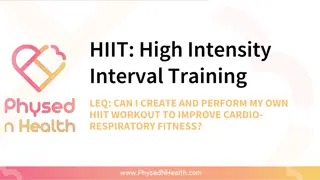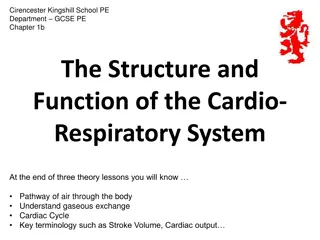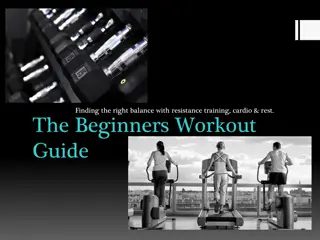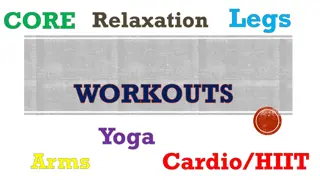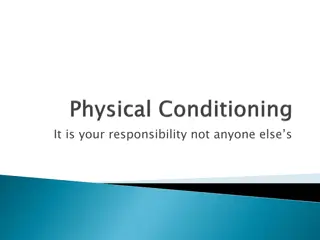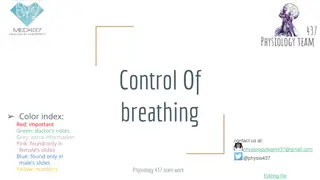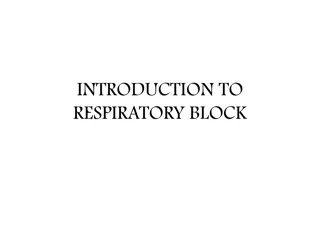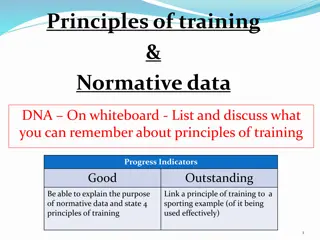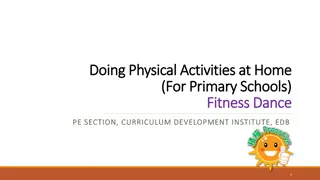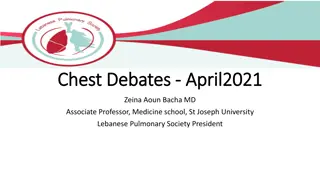Enhancing Cardio-Respiratory Fitness for Optimal Health Benefits
Cardio-respiratory training through a combination of aerobic and anaerobic exercises can significantly improve cardio-respiratory fitness, leading to numerous health benefits including enhanced heart health, better mental well-being, and increased social engagement. Immediate and long-term advantages of such training include mood elevation, improved cognitive function, reduced risk of lifestyle diseases, and increased life expectancy. By following the FITT principle and engaging in activities like walking, jogging, cycling, or swimming regularly, individuals can boost their cardiovascular endurance and overall well-being.
Download Presentation

Please find below an Image/Link to download the presentation.
The content on the website is provided AS IS for your information and personal use only. It may not be sold, licensed, or shared on other websites without obtaining consent from the author. Download presentation by click this link. If you encounter any issues during the download, it is possible that the publisher has removed the file from their server.
E N D
Presentation Transcript
CARDIO-RESPIRATORY TRAINING: AEROBIC & ANAEROBIC EXERCISE LEQ: CAN I IMPROVE CARDIO-RESPIRATORY FITNESS TO GAIN THE HEALTH BENEFITS OF CARDIO ENDURANCE?
Cardio-Respiratory Endurance A measure of how well your HEART, LUNGS, and MUSCLES work together for an extended period. Regular aerobic exercise improvesyour body s ability to provide oxygen to muscles during workouts. Using the FITT principle can help you develop a weekly plan to participate in aerobic exercise and improve cardio-respiratory fitness.
IMMEDIATE BENEFITS OF CARDIO- RESPIRATORY ENDURANCE TRAINING Boosts mood, energy, and productivity Supports restful sleep Increases confidence and self-efficacy Improves cognitive function and memory Decreases symptoms of depression and anxiety Participate in daily living tasks without fatigue Improves quality of life
LONG-TERM BENEFITS OF CARDIO- RESPIRATORY ENDURANCE TRAINING Improves heart health Reduces asthma symptoms Regulates blood sugar Lowers blood pressure and resting heart rate Strengthens immune system function Prevents lifestyle diseases Increases life expectancy
REFLECTION 1. WHAT ARE YOUR FAVORITE CARDIO- RESPIRATORY ENDURANCE ACTIVITIES? 2. WHAT ARE PHYSICAL HEALTH BENEFITS TO CARDIO-RESPIRATORY FITNESS? 3. WHAT ARE MENTAL HEALTH BENEFITS TO CARDIO-RESPIRATORY FITNESS? 4. WHAT ARE SOCIAL HEALTH BENEFITS TO CARDIO-RESPIRATORY FITNESS?
FITT PRINCIPLE FITT Principle: Helps people create a workout plan to achieve personalized goals. Frequency: How many Intensity: How Time: How Type: What a week? will you complete the task? of activity will you complete? is the workout?
FITT CARDIO F: 3-5 days a week I: moderate to vigorous intensity (60-85% of max heart rate) T: 30-45 minutes or at least 150 mins a week T: walk, jog, run, swim, cycle, active sports, HIIT, jump rope, trampoline, hike, dance, box, calisthenics, plyometrics
AEROBIC EXERCISE Endurance based exercises that increase heart and respiration rate while transporting and absorbing oxygen to perform movement over an extended period of time. 150-300 mins of moderate aerobic activity a week Moderate activity includes movement where a person can have a conversation while participating in the activity 75-150 mins of vigorous aerobic activity a week Vigorous activity includes movement where a person can only say 1-2 words while participating in the activity
Your physical and mental health will drastically improve by adopting a lifestyle that includes at least 30 minutes of aerobic activity 5 days a week.
REFLECTION 1. HOW MANY DAYS A WEEK DO YOU GET MODERATE TO VIGOROUS CARDIO- RESPIRATORY ENDURANCE ACTIVITY? 2. EXPLAIN THE DIFFERENCE BETWEEN MODERATE AND VIGOROUS INTENSITY. 3. HOW IS OXYGEN USED DURING AEROBIC ACTIVITY? 4. WHAT DAYS & TIMES ARE BEST FOR YOU TO BUILD AEROBIC ACTIVITY INTO YOUR WEEKLY ROUTINE FOR IMPROVED HEALTH & FITNESS?
AEROBIC VS ANAEROBIC STATION ACTIVTY LEARNING ASSIGNMENT Author: Caitlin Fregelette
ANAEROBIC EXERCISE Short bursts of intense activity using maximum power, speed, and explosion that does not involve the use of oxygen to perform the movement. Body does not transport or absorb oxygen fast enough to perform the movement, so it relies on glucose storage in the muscle. Movement is intense, short, and creates power through stored energy.
Adopt a lifestyle that includes AT LEAST 2 days of anaerobic exercise, focusing on all major muscle groups of the body.
AEROBIC ANAEROBIC Power, speed, and strength-based Endurance-based exercises Requires oxygen to perform movement Relies on energy storage to perform movement Long, sustained efforts of moderate intensity Short burst of intense activity Brisk walking, jogging, cycling, swimming Sprinting, jumping, weightlifting
AEROBIC VS ANAEROBIC EXERCISE Both aerobic and anaerobic exercises are beneficial for a person s health, although each benefits the body in different ways. The main differences are the: Body s use or nonuse of oxygen Intensity of the movement (speed, power, resistance) Length of time able to maintain movement Aerobic = Endurance Anaerobic = Strength
AEROBIC VS ANAEROBIC EXERCISE Similarities: Strengthens heart muscle Boosts circulation Increases metabolism Supports a healthy body fat composition Similarities: Regulates blood sugar Prevents dementia Decreases anxiety and depression Reduces risk of heart disease, cancer, and diabetes
REFLECTION 1. WHY DOES HEART RATE AND BREATHING RATE INCREASE DURING AEROBIC EXERCISE? 2. WHAT ARE SOME DIFFERENCES BETWEEN AEROBIC AND ANAEROBIC EXERCISE? 3. WHAT ARE SIMILARITIES BETWEEN AEROBIC AND ANAEROBIC EXERCISE? 4. USE ONE WORD TO DESCRIBE AEROBIC AND ANEROBIC.
CARDIO-RESPIRATORY QUIZ LEARNING ASSESSMENT


